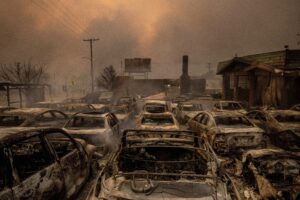How the Pentagon’s Forever Wars Are Killing the Planet
The Department of Defense is the single largest producer of greenhouse gases in the world, a Brown University report reveals. U.S. military helicopters at Camp Taji, Iraq. (Muh. Sirojul Munir / Flickr)
U.S. military helicopters at Camp Taji, Iraq. (Muh. Sirojul Munir / Flickr)
It’s been a harrowing couple of weeks for climate change observers. First, as Vice reported, there was an analysis from an Australian think tank, co-written by Ian Dunlop, a former fossil fuel company CEO, that posits that the planet is “reaching a ‘point of no return’ by mid-century, in which the prospect of a largely uninhabitable Earth leads to the breakdown of nations and the international order.’ ”
Then, on Wednesday, Brown University released a report revealing that the Department of Defense is “the world’s largest institutional user of petroleum and correspondingly, the single largest producer of greenhouse gases (GHG) in the world.” According to the report, the DOD released approximately 1.2 billion metric tons of greenhouse gases, including carbon dioxide, between 2001 and 2017.
Burning diesel and jet fuel for troop and weapons transport and usage causes 70% of the emissions, the report said.
In other words, the same institution that has kept America at war since 2001 is not only killing people, but also the planet. As CNBC pointed out, “The findings showed that if the Pentagon was listed as a country, its emissions would make it the world’s 55th largest contributor of greenhouse gases”—bigger than Portugal or Sweden.
CNBC called the report “the first of its kind to compile such comprehensive data.”
The Pentagon’s energy use was fairly stable from 1975 to 1990, and declined after the Cold War. Then came 9/11 and fighting in Afghanistan. After that, researcher Neta Crawford writes, “energy consumption by the DOD increased, and in 2005 hit its highest level in a decade. Since 2001 the DOD has consistently consumed between 77 and 80 percent of all US government energy consumption.”
“Unlike other elements of the current US administration,” she writes, the DOD acknowledges that climate change is an ongoing and dire issue. Crawford says that the department has made some improvements in terms of fossil fuel emissions, “[emphasizing] what it calls energy security — energy resilience and conservation” in its operations. Still, the agency remains a significant consumer of fossil fuel energy,” and ”there is room for much steeper cuts” to its carbon emissions and energy consumption.
Among Crawford’s suggestions for making those cuts are designing equipment with greater fuel economy, switching to alternative fuels, restructuring training, base closures, and reducing military operations worldwide.
If the DOD doesn’t cut its emissions and fuel consumption, Crawford warns that the consequences will be dire:
Absent any change in US military fuel use policy, the fuel consumption of the US military will necessarily continue to generate high levels of greenhouse gases. These greenhouse gases, combined with other US emissions, will help guarantee the nightmare scenarios that the military predicts and that many climate scientists say are possible.
Read the full report here.
Your support is crucial...As we navigate an uncertain 2025, with a new administration questioning press freedoms, the risks are clear: our ability to report freely is under threat.
Your tax-deductible donation enables us to dig deeper, delivering fearless investigative reporting and analysis that exposes the reality beneath the headlines — without compromise.
Now is the time to take action. Stand with our courageous journalists. Donate today to protect a free press, uphold democracy and uncover the stories that need to be told.






You need to be a supporter to comment.
There are currently no responses to this article.
Be the first to respond.